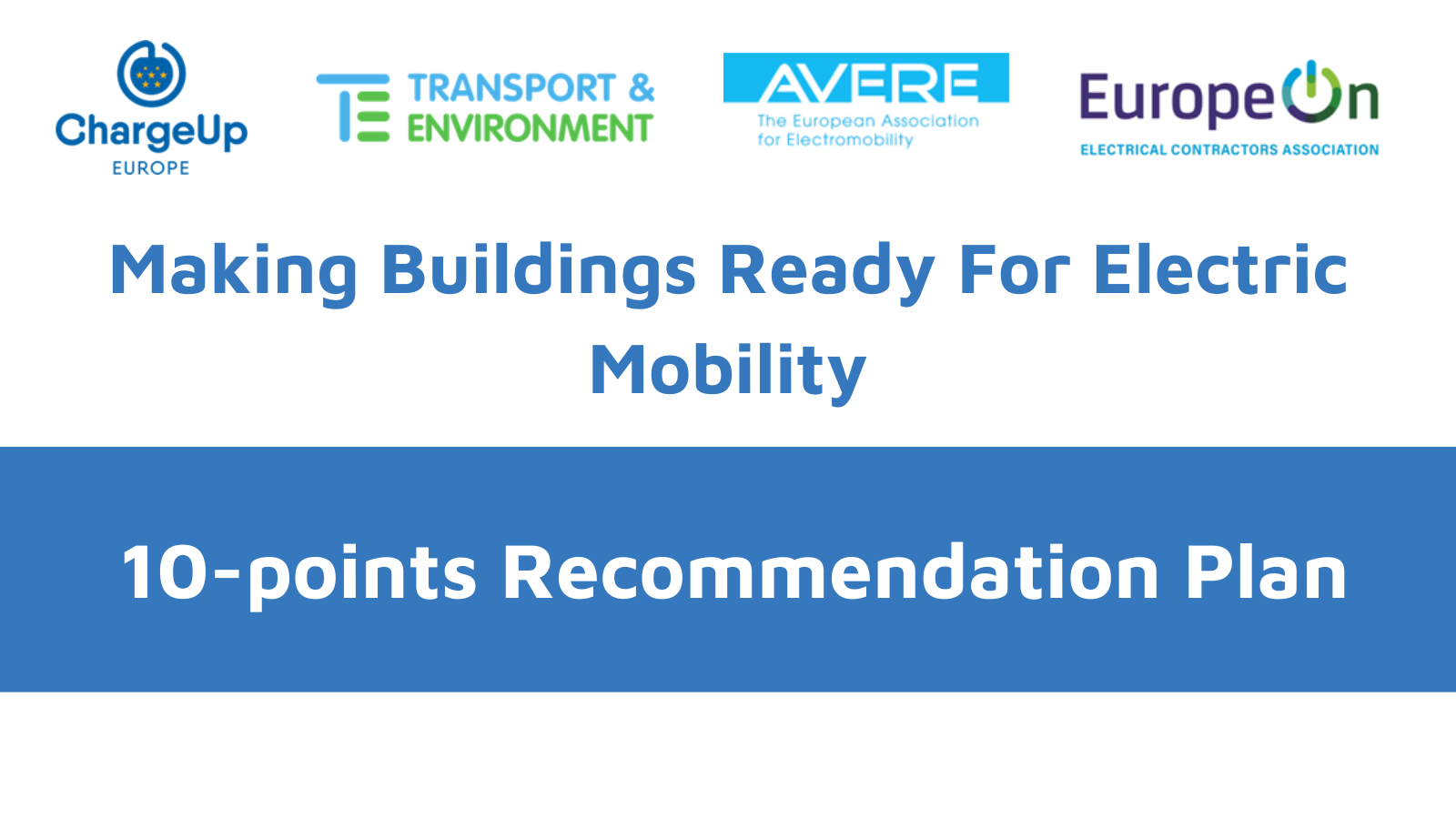




RECOMMENDATION PLAN
Making Buildings Ready For Electric Mobility
10-point recommendation plan:
1. All buildings, old and new, should be EV ready by 2035
2. Ensure buildings can interact with electric vehicles
3. Ensure wider integration between EVs and energy management and grid systems
4. Know what EV infrastructure is deployed where
5. Prioritize grid capacity and investment planning
6. Ensure smooth grid connection procedures and establish a Right to Plug
7. Develop uniform fire-safety recommendations
8. Include HDV charging infrastructure targets
9. Educate the workforce on building, installing, operating and maintaining EV charging infrastructure and related technologies
10. Introduce a definition of pre-cabling
.
We, the undersigned associations representing different parts of the e-mobility ecosystem, call on the EU institutions to amend the Energy Performance of Building Directive (EPBD) so that EV charging at home or at the workplace becomes easy and accessible for all.
More than 75% of EV charging will continue to take place at (semi-)private locations. The EPBD therefore plays a key role in the shift towards e-mobility and is central to satisfying EV driver needs. Although the current proposal is an important step in the right direction, more is necessary to meet the charging needs of electric vehicles. The Parliament and Council now have the unique opportunity to set the right conditions to guarantee that buildings are ready to cater for the fast-growing EV market.
We believe the following recommendations to be the minimum requirements to futureproof EV charging solutions in buildings:
1. All buildings, old and new, should be EV ready by 2035
To cater for the fast-rising EV demand, all buildings should be ready for EV charging by 2035. All buildings, residential and non-residential, existing and new ones, with more than 5 parking spaces should therefore ensure the installation of pre-cabling for 30% of the parking spaces by 2025, 70% of the spaces by 2030, and 100% by 2035
2. Ensure buildings can interact with electric vehicles
To enable the integration of the building management system and fully optimize balancing, storage and flexibility options, all newly deployed EV charging stations should be digitally connected and smart charging capable. Bi-directional charging should also be supported by the EPBD as it facilitates the integration of on-site PV in buildings and allows for the integration of buildings into the wider energy system.
3. Ensure wider integration between EVs and energy management and grid systems
The EPBD should ensure interoperability between all actors of the EV ecosystem as this would allow for the proper integration of buildings and EVs into the wider energy system. Additionally, open-non-discriminatory and uniform communication protocols and standards are key to ensure a seamless charging experience for the driver.
4. Know what EV infrastructure is deployed where
Member States must take a comprehensive view on all EV charging use cases and infrastructure planning (public and private) to ensure the smart deployment of EV chargers and grid investments. The EPBD should therefore introduce a reporting obligation on indicative capacity-based deployment targets under the national policy frameworks, as mandated under the AFIR proposal.
5. Prioritize grid capacity and investment planning
This is especially important for renovation projects, where extra capacity may be necessary in addition to what the building is already serviced with. An additional transfer station, grid connection point or reserved capacity may be required. At the same time, there is a clear need to ensure grid capacity optimization through the procurement of flexibility by system operators. This should be encouraged via smart and bi-directional charging as this may reduce the need for capacity investments.
6. Ensure smooth grid connection procedures and establish a Right to Plug
The EPBD should make it possible for any parking owner or tenant to install a charger. Many EU citizens have to cope with lacking (regulatory) procedures for requesting or installing charging infrastructure in buildings. Introducing a ‘Right to Plug’ should help overcome these regulatory hurdles and facilitate the easy and rapid installation of charging stations in parking places. It should ensure:
– Speedy connection: The time from the initial connection request from an EV user/representative to the DSO for installation of the connection should take no longer than 8 – 12 weeks for AC and 4 – 6 months for DC.
– Administrative peace-of-mind: Make it as easy as subscribing to an electricity provider. Member States or regions should set-up a ‘one stop shop’ which provides an overview of the legislation in place and the rights citizens have. The website should also provide assistance and guidance throughout the EV charging installation process. All information should be available in the national language and in English.
7. Develop uniform fire-safety recommendations
The EU should issue recommendations to guide local and regional fire safety regulations regarding the deployment of home-/workplace and destination chargers, while ensuring that fire safety is guaranteed.
8. Include HDV charging infrastructure targets
Heavy duty vehicle charging solutions are currently not covered by the EPBD. However, we believe that minimum pre-cabling requirements at new and existing depots and logistics hubs should be introduced.
9. Educate the workforce on building, installing, operating, and maintaining EV charging infrastructure and related technologies
To effectively ensure the deployment of EV charging, it will be important to build the capacity and knowledge of those who carry out work on the ground, with local officials in particular. It is also important to train existing professionals (e.g., building designers, building managers, electrical inspectors, etc.) on how to design for the electrified future.
10.Introduce a definition of pre-cabling
We would support the inclusion of the following definition: “Pre-cabling includes all measures that are necessary to enable the technical and electrical installation of recharging points at a later date. This includes cable routes, space for transformers and electricity meters, as well as grid capacities and electrical installation. Electrical installation means the system that is composed of all the fixed components (such as switchboards, electric cables, earthing systems, sockets, switches, and light fittings) aiming to distribute electrical power within a building to all points of use including recharging points or transmit electricity generated on-site.”

